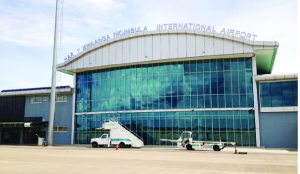
•THE Harry Mwanga Nkumbula International Airport got a facelift during the UNWTO to accomodate the increased tourist arrival in Livingstone during the General Assembly.
By SAM PHIRI –
SINCE 1980, the United Nations World Tourism Organisation has celebrated the World Tourism day of September 27. This year is no exception with a fresh theme “Tourism and Community Development.”
Apparently, this day was chosen and arrived at in respect of the adoption of the Statutes of the United Nations World Tourism Organisation (UNWTO) in 1970 that happened on the same date.
This year’s (2014) World Tourism Day marks the 34th anniversary of celebrations that are known to contribute more than nine per cent to the World’s economy.
Like any other nation under the United Nations umbrella, Zambia is celebrating this important day with the rest of the world alongside her 50th Independence anniversary.
Now, the main purpose of this day has been described as one that is meant to raise awareness on the significant role of tourism within the international community and demonstrate how it positively affects social, cultural, political and economic values worldwide.
This year 2014 World Tourism Day is being celebrated under an inspirational theme “Tourism and Community Development” – mainly focusing on the ability of sector in empowering people and providing them with skills to achieve change in their local communities.
Critically looking and analysing this year’s theme, it might have different interpretations from all spheres of the tourism endeavours though significantly it comes to rest on the base of empowering people with skills to achieve change in their community.
Zambia is one country with vast tourism attractions though many people living in or in the vicinity of such places lack skills of developing these sites and turning them into lucrative business points.
Without doubt, Zambia is one of awakening tourism giants; looking vitally at its abundance of wildlife, unspoiled landscape of rivers and lakes, plains and forestry.
From the river water bodies alone would unfold beauty of captivating features like waterfalls, rapids etc of which if well developed and promoted would contribute positively in developing the community in close proximity.
Going by the study and facts, tourism is one sector that has a huge ability of developing the community, socially, culturally and politically.
Politically, Zambia remains among the least disturbed and less commercialised countries in the entire continent of Africa thereby opening a clean suggestive window of great tourism decant to the country.
It remains a reality that despite all these natural resources Zambia possesses, that include some of the world wonders- the Vitoria falls, the Zambian tourism has not reached its zenith.
This is why the Government of Zambia has taken tourism seriously looking at its proven potential of developing the Zambian communities.
According to the study recently, Zambia’s tourism accounts for less than three per cent Gross Domestic Product (GDP).
Zambia has more than 18 national parks and over 30 game management areas which in total would cover 33 per cent of the country.
Despite this huge number, only five per cent of this has been developed to attractive and acceptable tourism standards according to the United Nations Tourism World Organisation.
This is a status core the Government is determined to change it for the better. The determination is that the current situation should be at least doubled were tourism intake is concerned by the coming year.
The 2014-2016 Strategic Plan for Zambia tourism proposes a central aspiration for this peaceful nation to be among the top five African tourist destinations of choice by 2030- a plan that is attainable even before the stipulated timeframe.
In this plan, there are two main highlighted goals, the first being the effort to increase the tourism and arts sector contribution to GDP from 2.1 per cent in 2012 to six per cent in 2016 and the other, to increase employment creation from 30,000 in 2012 to 300,000 in 2016.
The plan further underlines the need for the creation of a conducive investment climate in order to stimulate and strengthen private sector participation in the Zambian tourism industry.
Following the realisation that tourism product diversification is essential in widening the tourism product base; the plan aims to consider ways of attracting and increasing the length of stay for tourists and enhancing local community participation in tourism.
Zambia’s direct annual tourism earnings have risen from US$216 million in 2011 to $240 million in 2012 and the sector employed 44,292 people in 2012 from 20,000 in 2011.
The Zambian Government under the Patriotic Front (PF) has prioritised the tourism sector as one of four key sectors for job creation. Both the Vision 2030 and the revised SNDP will serve as vehicles to realise the Government’s development agenda.
In tune with this year’s theme, the Government is clearly working hard to develop the community of Zambia though the available and abandant natural resources.
Zambia is a peaceful and stable country with friendly welcoming people. Zambia can also boast of rich cultural background which can link the local people almost directly to developing their communities.
Some of the cultural aspects that have benefited a lot of Zambian communities are traditional ceremonies like the Kuomboka of the Lozi people of the Western part of Zambia.
Like Livingstone, Western Province has a myriad of guest houses that are usually fully booked during the Kuomboka season by the flood of tourists. This indeed goes well with this year’s theme “Tourism and Community Development.”






